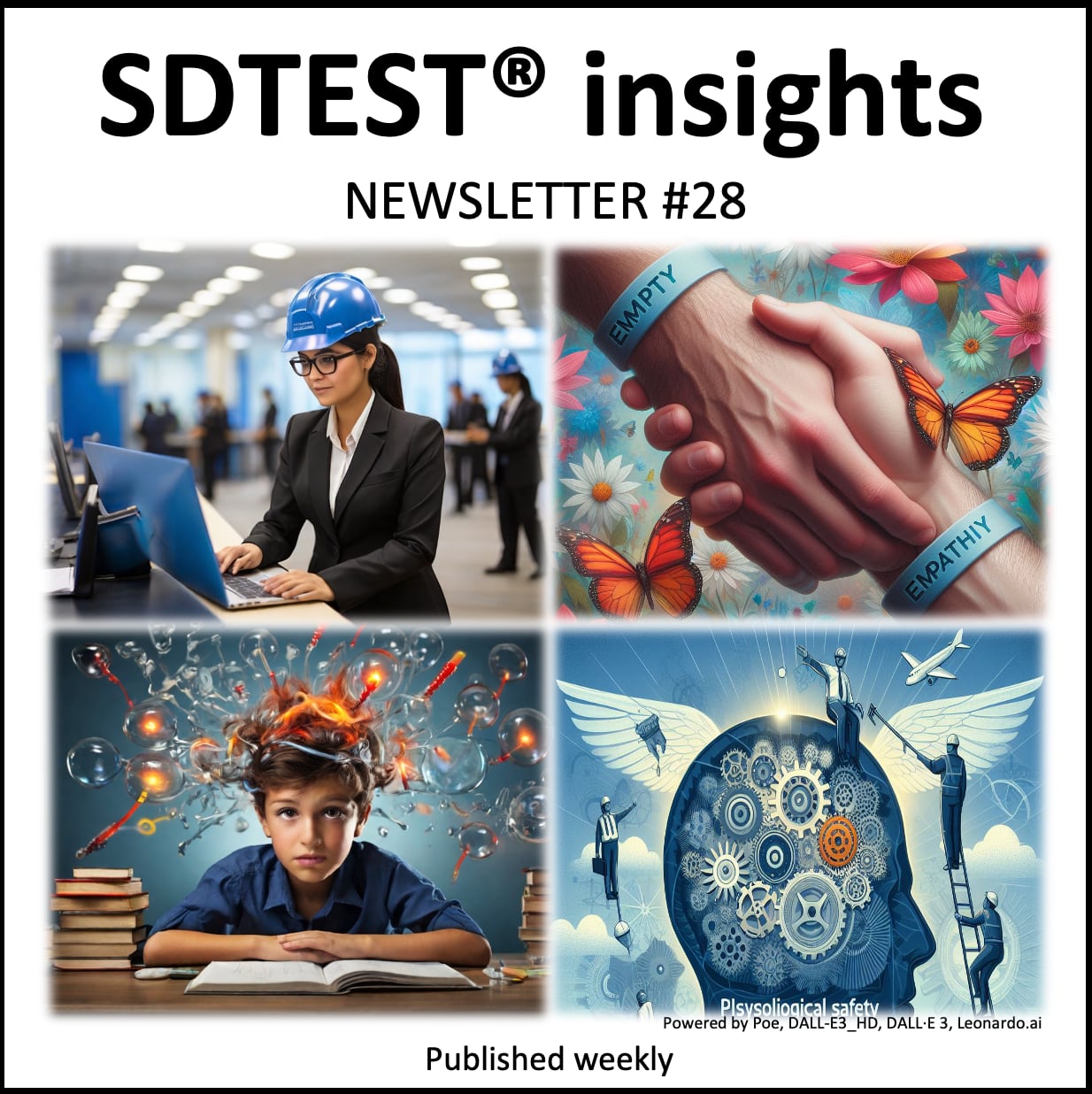SDTEST® has 36 different VUCA polls that calculate the 13,034 correlation values between stages of development according to the theory of Spiral Dynamics and answer options of these 36 polls.
We invite curiosity about the systemic mechanisms behind this correlation. There may be hidden variables that provide alternative explanations.
In our analysis of the poll "Does ageism exist?", we found an intriguing positive correlation that warrants closer examination:
0.2611 between the Yes, ageism exists within my family and community and the Purple stage (Germany, 2 languages).
The critical value of the correlation coefficient for a non-normal distribution, by Spearman r = 0.1305. This positive correlation of 0.2611 meets the reliability criteria but does not necessarily imply causation.
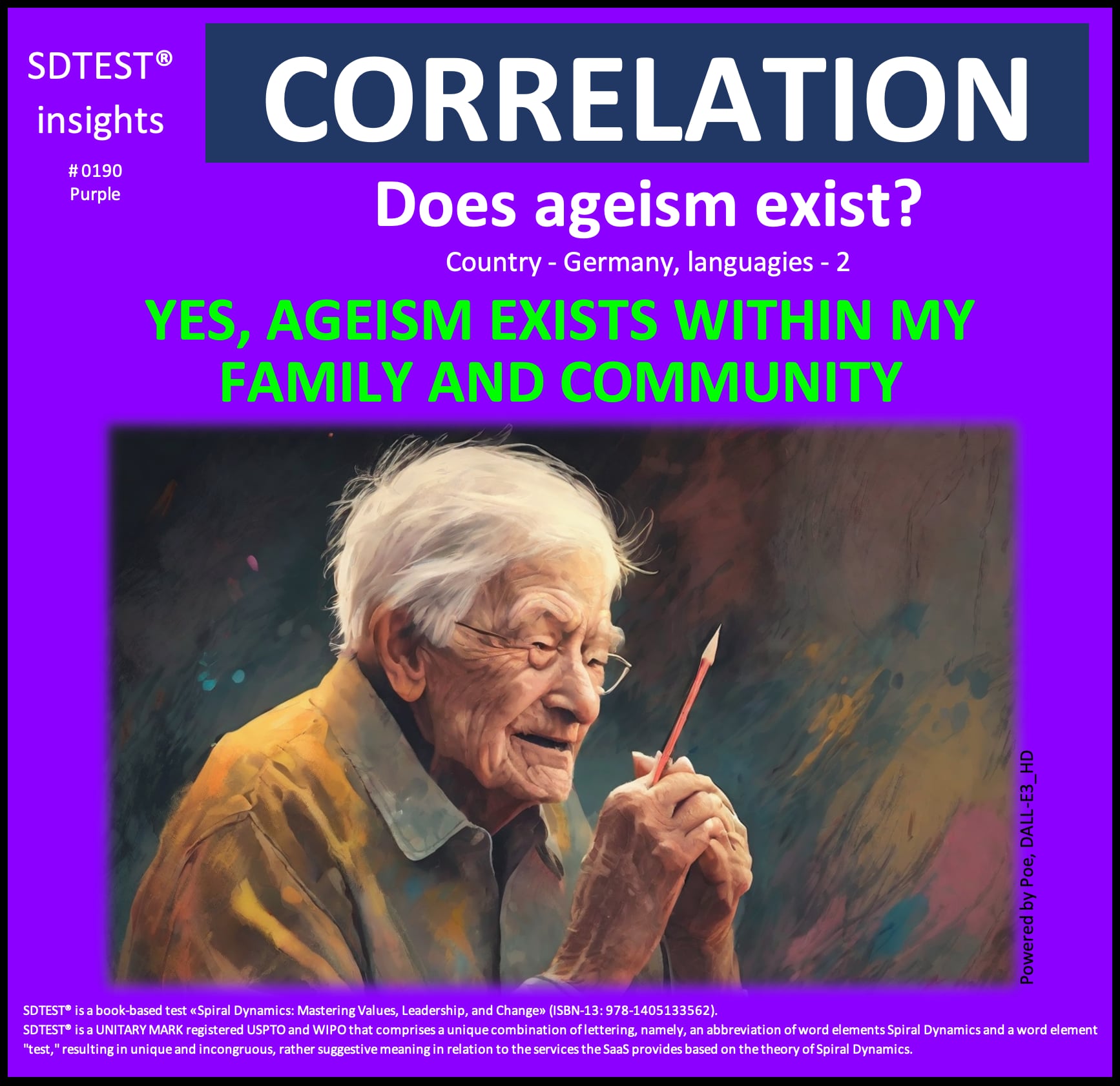
This positive correlation of 0.2611 between recognizing ageism within family and community and the Purple stage in Germany offers intriguing insights when viewed through the lens of the Purple value system, considering Germany's modern context:
Organizational Perspective:
Organizations operating within the Purple mindset in modern Germany might interpret this correlation as:
- A reflection of the tension between traditional family structures and Germany's rapidly aging population.
- An indication that some communities, particularly those with strong migrant backgrounds, may be grappling with integrating traditional age-based respect systems within Germany's egalitarian society.
- This is a sign of growing awareness of ageism, even in close-knit communities, possibly due to increased public discourse.
These organizations might respond by:
- Implementing intergenerational programs that bridge traditional respect for elders with modern concepts of active aging.
- Organizing cultural exchange events that explore different cultural perspectives on aging within Germany's diverse population.
- Seeking guidance from community leaders on maintaining cultural identity while adapting to Germany's anti-discrimination laws and social norms.
Team Perspective:
Teams operating from a Purple mindset in contemporary Germany might approach this correlation by:
- Viewing it as a call to balance traditional hierarchies with Germany's strong emphasis on workplace equality.
- Interpreting it as a need to create inclusive team environments that value experience and innovation.
- Seeing it as an opportunity to strengthen team cohesion by addressing ageism openly while respecting cultural sensitivities.
These teams might respond by:
- Establishing mentorship programs that emphasize reciprocal learning between generations.
- Incorporating inclusive decision-making processes that give voice to all age groups while respecting traditional wisdom.
- Developing team-building activities that celebrate diverse age-related perspectives within German work culture.
Individual Perspective:
Individuals aligned with the Purple value system in modern Germany might interpret this correlation as:
- A personal challenge to reconcile traditional family roles with Germany's emphasis on individual autonomy.
- An opportunity to bridge their cultural heritage with Germany's progressive stance on age equality.
- A call to actively engage in community initiatives that address ageism while preserving cultural values.
These individuals might respond by:
- Seeking dialogue with family members to address ageist attitudes while respecting family traditions.
- Participating in local community groups that focus on intergenerational understanding and cooperation.
- Exploring how their cultural background can contribute to Germany's ongoing discussions about creating an age-friendly society.
This correlation, viewed through the Purple lens in modern Germany, suggests a complex interplay between traditional values and the country's progressive social policies. Those with strong Purple values are increasingly aware of ageism, possibly due to the contrast between their traditional views and Germany's public emphasis on age equality.
Ultimately, this correlation speaks to Germany's ongoing cultural integration and adaptation process. It reminds us that addressing ageism in this context requires a nuanced approach that respects cultural diversity while upholding the principles of equality and non-discrimination that are fundamental to modern German society.
This interpretation also raises important questions about how Germany can leverage its cultural diversity to develop more comprehensive strategies for combating ageism. It challenges us to consider how the country can create policies and social norms that are both culturally sensitive and aligned with its commitment to equality for all age groups.
By embracing these insights, Germany may uncover innovative approaches to addressing ageism that draw on the strengths of its diverse population, fostering a richly multicultural society and unequivocally committed to age equality.
In our analysis of the poll "A.I. and the end of civilization" (by Elon Musk), we found an intriguing positive correlation that warrants closer examination:
0.0999 between the Artificial intelligence is dangerous to human civilization / Strongly disagree and the Red stage.
The critical value of the correlation coefficient for a normal distribution, by William Sealy Gosset (Student) r = 0.0823. This positive correlation of 0.0999 meets the reliability criteria but does not necessarily imply causation.

This positive correlation of 0.1039 between strongly disagreeing that AI is dangerous to human civilization and the Red stage offers intriguing insights when viewed through the lens of the Red value system:
Organizational Perspective:
Organizations operating within the Red mindset might interpret this correlation as:
- Validation of their aggressive pursuit of AI technology without concern for potential long-term consequences.
- An opportunity to dominate competitors by embracing AI without hesitation or ethical constraints.
- Justification for dismissing cautionary voices as weak or irrelevant to their power-driven goals.
These organizations might respond by:
- Accelerating AI adoption to gain immediate competitive advantages, regardless of potential risks.
- Implementing AI systems that maximize short-term profits and power consolidation.
- Aggressively marketing their AI capabilities as a sign of strength and dominance in the market.
Team Perspective:
Teams operating from a Red mindset might approach this correlation by:
- Viewing it as a call to action to outperform other teams in AI implementation and utilization.
- Interpreting it as a license to push AI boundaries without concern for ethical implications.
- Seeing it as an opportunity to assert their superiority through fearless AI adoption.
These teams might respond by:
- Engaging in cut-throat competition to develop the most powerful AI applications.
- Dismissing team members who express concerns about AI risks as weak links.
- Celebrating aggressive, risk-taking behaviors in AI development and deployment.
Individual Perspective:
Individuals aligned with the Red value system might interpret this correlation as:
- Personal validation of their fearless attitude towards technological advancement.
- An opportunity to assert dominance by embracing AI more aggressively than others.
- Justification for disregarding potential AI dangers in pursuit of personal power and gain.
These individuals might respond by:
- Seeking ways to leverage AI for immediate gratification and power accumulation personally.
- Challenging or mocking those who express concerns about AI risks.
- Aggressively promoting themselves as fearless AI adopters and visionaries.
This correlation, viewed through the Red lens, suggests that those operating at the Red level may be more inclined to dismiss potential AI dangers due to their focus on immediate power and dominance. It implies that the Red value system's impulsiveness, self-centeredness, and disregard for long-term consequences align with a dismissive attitude toward AI risks.
Ultimately, this correlation shows the complex relationship between human values and technological advancement. It reminds us that in the Red worldview, the potential for immediate power and dominance through AI may outweigh considerations of long-term societal impacts or ethical concerns.
This interpretation also raises important questions about the role of diverse value systems in shaping the future of AI. It challenges us to consider how we can navigate the development of powerful technologies in a world where different value systems coexist and compete for influence.
By examining this correlation through the Red lens, we gain insights into the motivations and attitudes that may drive certain AI development and adoption approaches. This understanding can inform strategies for addressing AI risks and fostering more responsible innovation, even in environments where immediate power and self-interest are primary motivators.
In our analysis of the poll "What makes a boss a great leader?" we found an intriguing negative correlation that warrants closer examination:
-0.3083 between the Empathy and the Blue stage (Belgium, 3 languages).
The critical value of the correlation coefficient for a non-normal distribution, by Spearman r = 0.1034. This negative correlation of -0.3083 meets the reliability criteria but does not necessarily imply causation.

This negative correlation of -0.3083 between Empathy and the Blue stage in Belgium, a country known for its complex linguistic and cultural landscape, offers intriguing insights when viewed through the lens of the Blue value system:
Organizational Perspective:
Organizations operating within the Blue mindset in Belgium might interpret this correlation as:
- A challenge to the established order in a country with three official languages (Dutch, French, and German) and distinct cultural regions.
- An indication that empathy may conflict with maintaining the strict discipline necessary in a multilingual, multicultural society.
- A need to reinforce the importance of duty and loyalty to national institutions over individual or regional emotional considerations.
These organizations might respond by:
- Implementing rigorous training programs to reinforce traditional Belgian values across all linguistic communities.
- Revising codes of conduct to clarify the role of empathy within the established hierarchies of Belgian society.
- Launching initiatives to strengthen organizational loyalty and commitment to shared Belgian principles, transcending regional differences.
Team Perspective:
Teams operating from a Blue mindset in Belgium might approach this correlation by:
- Viewing it as a call to reinforce team unity through shared Belgian values and traditions, regardless of linguistic background.
- Interpreting it as a need to balance empathy with unwavering commitment to team objectives in a diverse work environment.
- Seeing it as an opportunity to strengthen adherence to established protocols that ensure fairness across all cultural groups.
These teams might respond by:
- Conducting team-building exercises focused on duty, loyalty, and collective responsibility to the Belgian state and its institutions.
- Implementing more explicit guidelines for appropriate displays of empathy within the team structure, respecting Belgian cultural norms.
- Recognizing and rewarding team members who exemplify dedication to Belgian values and rules, promoting national unity.
Individual Perspective:
Individuals aligned with the Blue value system in Belgium might interpret this correlation as:
- A reminder of the importance of maintaining personal discipline and adherence to Belgian moral codes and civic duties.
- An opportunity to demonstrate loyalty by prioritizing national needs over personal or regional empathy.
- A call to reflect on how to balance empathy with an unwavering commitment to established Belgian norms and traditions.
These individuals might respond by:
- Seeking guidance from respected Belgian authorities on how to appropriately express empathy within their role as citizens.
- Recommitting to personal study of Belgian history, values, and codes of conduct.
- Striving to set an example of proper behavior that balances empathy with duty and discipline in a multilingual, multicultural context.
This correlation, viewed through the Blue lens in the Belgian context, suggests that those operating at the Blue level may experience tension between empathy and their strong commitment to order, rules, and tradition in a complex society. It implies that the Blue value system's characteristics of conformity, loyalty to authority, and adherence to established moral codes may sometimes conflict with expressions of empathy across linguistic and cultural divides.
Ultimately, this correlation speaks to the complex relationship between Belgian organizational values and human emotions in a multilingual, multicultural society. It reminds us that the commitment to order and established norms in the Blue worldview may sometimes overshadow considerations of individual or regional emotional needs or interpersonal connections across cultural boundaries.
This interpretation also raises important questions about the role of empathy in traditional, hierarchical structures within Belgium's unique societal makeup. It challenges us to consider how we can maintain order and discipline while also fostering appropriate levels of empathy and understanding within Belgian organizations and institutions.
By examining this correlation through the Blue lens in the Belgian context, we gain insights into the potential conflicts between strict adherence to national rules and the expression of empathy in leadership across diverse communities. This understanding can inform strategies for developing more balanced leadership approaches that honor traditional Belgian values while also recognizing the importance of empathy in human interactions within a complex, multilingual society.
In our analysis of the poll "Why do people procrastinate?" we found an intriguing negative correlation that warrants closer examination:
-0.1430 between the ADHD (Attention-Deficit/Hyperactivity Disorder): Difficulty in sustaining attention and staying organized, resulting in delayed task completion / Highly Applicable and the Orange stage.
The critical value of the correlation coefficient for a normal distribution, by William Sealy Gosset (Student) r = 0.0748. This negative correlation of -0.1430 meets the reliability criteria but does not necessarily imply causation.
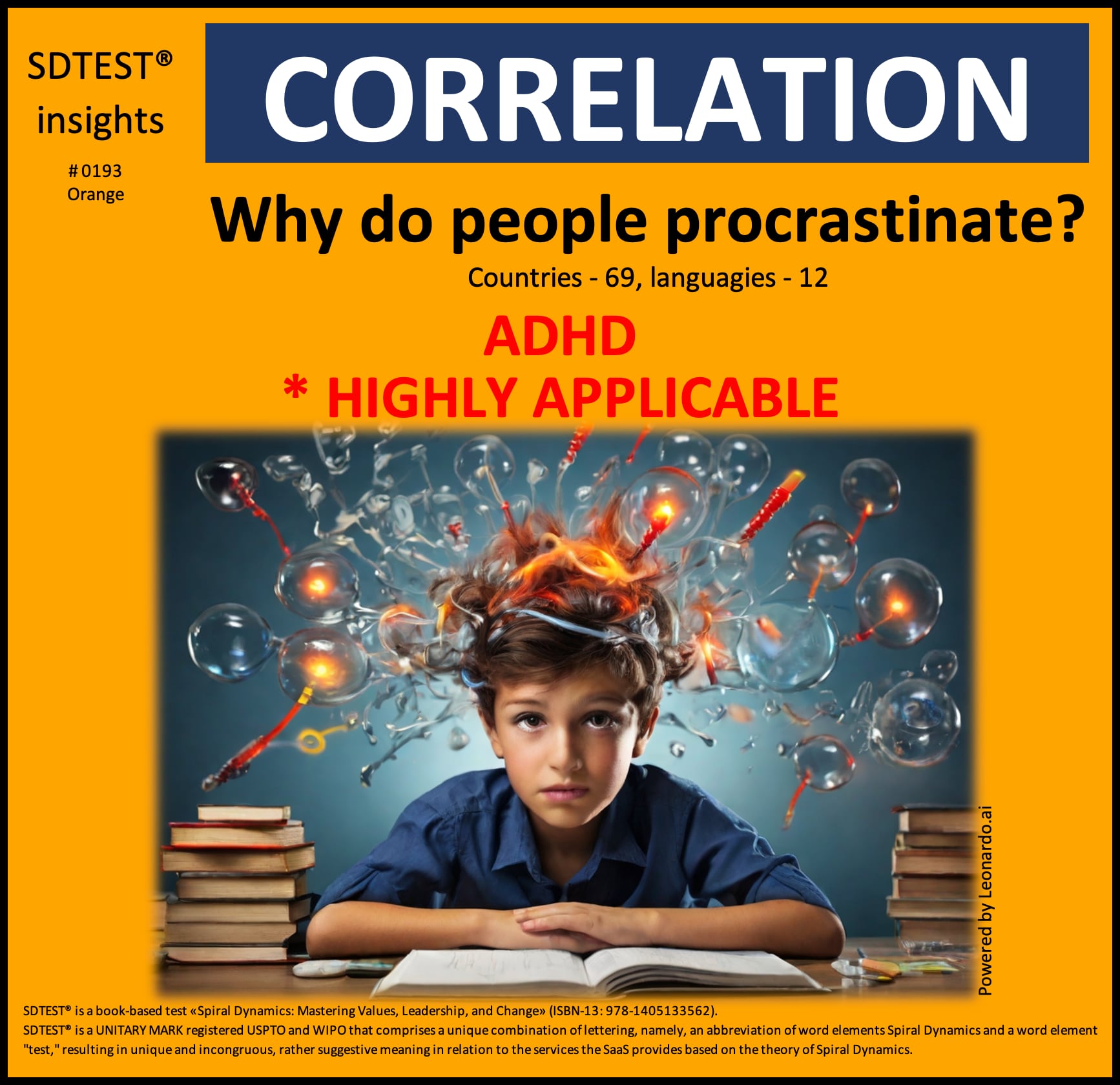
This negative correlation of -0.1430 between "Highly Applicable" ADHD (Attention-Deficit/Hyperactivity Disorder) and the Orange stage indicates that ADHD is actually Not Highly Applicable in the Orange value system. This offers intriguing insights when viewed through the lens of the Orange value system:
Organizational Perspective:
Organizations operating within the Orange mindset might interpret this correlation as:
- Validation of their focus on efficiency, structure, and goal-oriented processes.
- An indication that their systems and culture may naturally mitigate ADHD-related challenges.
- Confirmation that their rational, results-driven approach aligns well with cognitive styles that thrive on order and focus.
These organizations might respond by:
- Doubling down on data-driven, structured work environments that inherently support attention and organization.
- Implementing even more robust project management and productivity tracking systems.
- Marketing their organizational culture as one that fosters focus and achievement.
Team Perspective:
Teams operating from an Orange mindset might approach this correlation by:
- Viewing it as an affirmation of their methodical, goal-oriented approach to teamwork.
- Interpreting it as evidence that their structured collaboration methods are effective.
- Seeing it as an opportunity to refine their processes for maximum efficiency and focus.
These teams might respond by:
- Enhancing their use of project management tools and methodologies to maintain high productivity.
- Implementing more stringent performance metrics to drive focus and results.
- Developing training programs that reinforce attention management and organizational skills.
Individual Perspective:
Individuals aligned with the Orange value system might interpret this correlation as:
- Personal validation of their structured, goal-driven approach to work and life.
- An opportunity to leverage their natural tendencies towards focus and organization for career advancement.
- Confirmation that their cognitive style aligns well with high-performance environments.
These individuals might respond by:
- Further honing their time management and organizational skills as a competitive advantage.
- Seeking out roles and responsibilities that reward their ability to maintain focus and drive results.
- Promoting their capacity for sustained attention and goal achievement in professional settings.
This correlation, viewed through the Orange lens, suggests that the characteristics of the Orange value system - such as rational thinking, goal orientation, and structured approaches - may naturally counteract or be incompatible with ADHD tendencies. It implies that environments and individuals operating at the Orange level may inherently foster or select cognitive styles prioritizing focus, organization, and linear goal achievement.
Ultimately, this correlation shows the complex relationship between societal/organizational values and neurocognitive diversity. It reminds us that emphasizing efficiency, logic, and results-driven behavior in the Orange worldview may create an environment where ADHD-like traits are less prevalent or less impactful.
In our analysis of the poll "Ageism in Career," we found an intriguing positive correlation that warrants closer examination:
0.5436 between the Yes, our organization has systems in place to deal with cases of ageism and the Green stage (Great Britain, 2 languages).
The critical value of the correlation coefficient for a normal distribution, by William Sealy Gosset (Student) r = 0.5338. This positive correlation of 0.5436 meets the reliability criteria but does not necessarily imply causation.

This positive correlation of 0.5436, viewed through the Green lens, suggests a positive alignment between organizational systems and values prioritizing inclusivity, respect, and holistic well-being. It implies that as societies and organizations evolve towards more Green-oriented value systems, they become more adept at addressing complex social issues like ageism.
Organizational Perspective:
From a Green organizational standpoint, this positive correlation between having systems to address ageism and the Green stage is deeply encouraging. This correlation suggests that:
- Our holistic approach to organizational culture successfully addresses systemic biases.
- Our emphasis on intergenerational harmony and mutual respect manifests in tangible policies.
- We're progressing in creating a work environment where all individuals, regardless of age, can thrive and contribute.
As an organization, we might respond by:
- Sharing these findings transparently with all stakeholders to foster dialogue and further improvement.
- Exploring how we can extend our anti-ageism systems to address other forms of discrimination.
- Initiating collaborative projects that leverage different age groups' diverse experiences and perspectives.
Team Perspective:
From a Green team perspective, this correlation affirms our collective efforts to create an inclusive team environment. It suggests that:
- Our focus on open communication and mutual understanding is helping to bridge generational gaps.
- Our team's commitment to valuing each member's unique contributions, regardless of age, is being supported by organizational systems.
- We're cultivating a team culture that equally recognizes the wisdom of experience and youth innovation.
As a team, we might respond by:
- Facilitating intergenerational mentoring and reverse-mentoring programs within the team.
- Organizing team-building activities that celebrate age diversity and promote empathy.
- Collectively reflecting on how we can further dismantle age-related stereotypes in our daily interactions.
Individual Perspective:
As an individual aligned with Green values, this correlation resonates with my personal commitment to fostering inclusivity and respect for all. It suggests that:
- My efforts to challenge my own age-related biases and promote intergenerational understanding are part of a larger, positive trend.
- The organization I'm part of aligns with my values of equity and respect for all individuals.
- There's a supportive framework in place for me to continue growing and contributing, regardless of my age.
As an individual, I might respond by:
- Actively seeking out colleagues of different ages to collaborate with and learn from.
- Reflecting on my own experiences with ageism and sharing them to raise awareness.
- Advocating for the expansion of anti-ageism initiatives to address intersectional discrimination issues.
This positive correlation speaks to the potential for organizational policies to reflect and reinforce values of community, ecology, and universal well-being. It reminds us that in the Green worldview, addressing issues like ageism is not just about compliance or productivity but about creating a more just and harmonious society for all.
This interpretation also raises important questions about organizations' role in societal progress. It challenges us to consider how we can use organizational systems as catalysts for broader social change, promoting values of inclusivity and respect beyond the workplace.
By examining this correlation through the Green lens, we gain insights into the positive feedback loop between progressive organizational policies and evolving societal values. This understanding can inform strategies for creating more inclusive, sustainable, and harmonious work environments that contribute to the well-being of all members of society, regardless of age or other demographic factors.
In our analysis of the poll "Factors that impact team effectiveness," we found an intriguing positive correlation that warrants closer examination:
0.2120 between the Psychological Safety and the Yellow stage (Great Britain, English).
The critical value of the correlation coefficient for a non-normal distribution, by Spearman r = 0.0982. This positive correlation of 0.2120 meets the reliability criteria but does not necessarily imply causation.
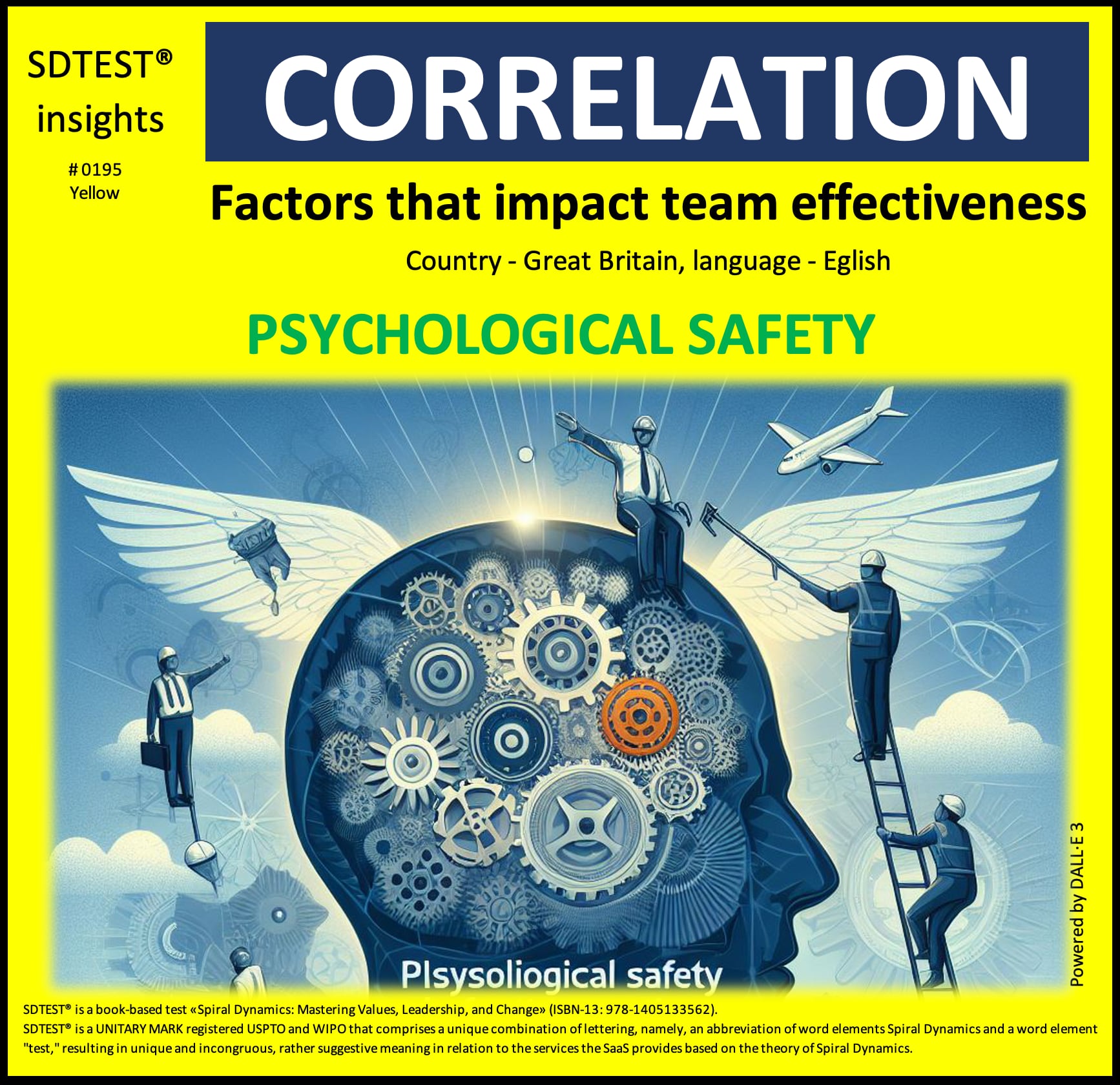
This positive correlation of 0.2120 between Psychological Safety and the Yellow stage offers a fascinating insight into the complex interplay of team dynamics and advanced cognitive frameworks in Great Britain. Here's an analysis from three viewpoints:
Companies Perspective:
- Integrative Perspective: This correlation suggests that as British organizations evolve towards more complex, adaptive systems (Yellow stage), they naturally cultivate environments of psychological safety. This is particularly relevant in the post-Brexit, post-pandemic era, where companies navigate new economic landscapes and hybrid work models.
- Systemic Approach: Companies might view this as validation of their efforts to create flexible, learning-oriented cultures that address the challenges of the modern British workplace, including diversity, sustainability, and work-life balance.
- Adaptive Strategy: Yellow-level companies in Britain might use this insight to design even more nuanced approaches to fostering psychological safety, recognizing it as both a catalyst for and an outcome of advanced organizational thinking in a rapidly changing societal context.
Response:
- Implement cross-functional "safe spaces" for idea exchange, encouraging the integration of diverse perspectives from Britain's multicultural workforce and exploring complex systemic challenges like climate change adaptation and social inequality.
Teams Perspective:
- Multi-dimensional View: Teams might interpret this correlation as evidence of the synergy between cognitive complexity and emotional intelligence, crucial in navigating the complexities of modern British society, including regional disparities and cultural diversity.
- Emergent Dynamics: Yellow-level teams could see this as confirmation of the emergent properties of advanced group dynamics, where psychological safety isn't just a goal but a natural byproduct of high-level collective thinking necessary in addressing Britain's evolving social and economic landscape.
- Feedback Loops: Teams might explore how psychological safety and Yellow-stage thinking reinforce each other in a positive feedback loop, driving continuous growth and adaptation in the face of challenges like automation, gig economy expansion, and the need for sustainable urban development.
Response:
- Develop team practices that simultaneously challenge cognitive boundaries and reinforce psychological safety, such as "assumption-challenging" exercises conducted in a supportive, non-judgmental setting, addressing topics like the future of work in Britain or the impact of AI on society.
Individuals Perspective:
- Personal Evolution: Individuals might view this correlation as an affirmation of their personal growth journey in Britain's evolving society, where adaptability and complex thinking are increasingly valuable.
- Cognitive-Emotional Integration: This insight might encourage individuals to explore further the interplay between their cognitive frameworks and emotional experiences, seeing both as crucial aspects of their development in a nation grappling with issues of national identity, social justice, and global positioning.
- Systemic Self-Awareness: Yellow-level thinkers might use this correlation to deepen their understanding of how their personal evolution influences and is influenced by the systems they're part of, including Britain's healthcare system, education sector, and political landscape.
Response:
- Engage in practices that simultaneously stretch cognitive abilities and emotional intelligence, such as participating in diverse think tanks or cross-cultural dialogue groups addressing Britain's role in global affairs or local community development initiatives.
From a Yellow perspective, this correlation invites us to explore the intricate relationships between cognitive complexity, emotional safety, and systemic thinking in the context of modern Britain. As we evolve towards more integrative, holistic understandings of the world, we naturally create environments that support psychological well-being and open expression, which is particularly crucial in a society facing rapid technological change, demographic shifts, and environmental challenges.
This correlation challenges us to think beyond simple cause-effect relationships and consider the emergent properties of complex human systems within the British context. It prompts questions like: How do psychological safety and advanced cognitive frameworks co-evolve in a post-Brexit Britain? Considering the nation's unique blend of tradition and innovation, what other factors might be at play in this relationship?
In conclusion, this correlation offers a glimpse into the interconnected nature of personal, team, and organizational development at advanced stages of consciousness within the specific context of Great Britain. It invites us to continue exploring the subtle dynamics in high-functioning human systems, always remaining open to new insights and perspectives as Britain navigates its evolving role on the global stage and addresses domestic challenges.
In our analysis of the poll "Meritocracy" (Does the organization provide opportunities for training and development to help employees acquire the necessary skills and knowledge to advance their careers?), we found an intriguing positive correlation that warrants closer examination:
0.5672 between the Yes, the organization provides opportunities and the Turquoise stage (France, French).
The critical value of the correlation coefficient for a non-normal distribution, by Spearman r = 0.2367. This positive correlation of 0.5672 meets the reliability criteria but does not necessarily imply causation.
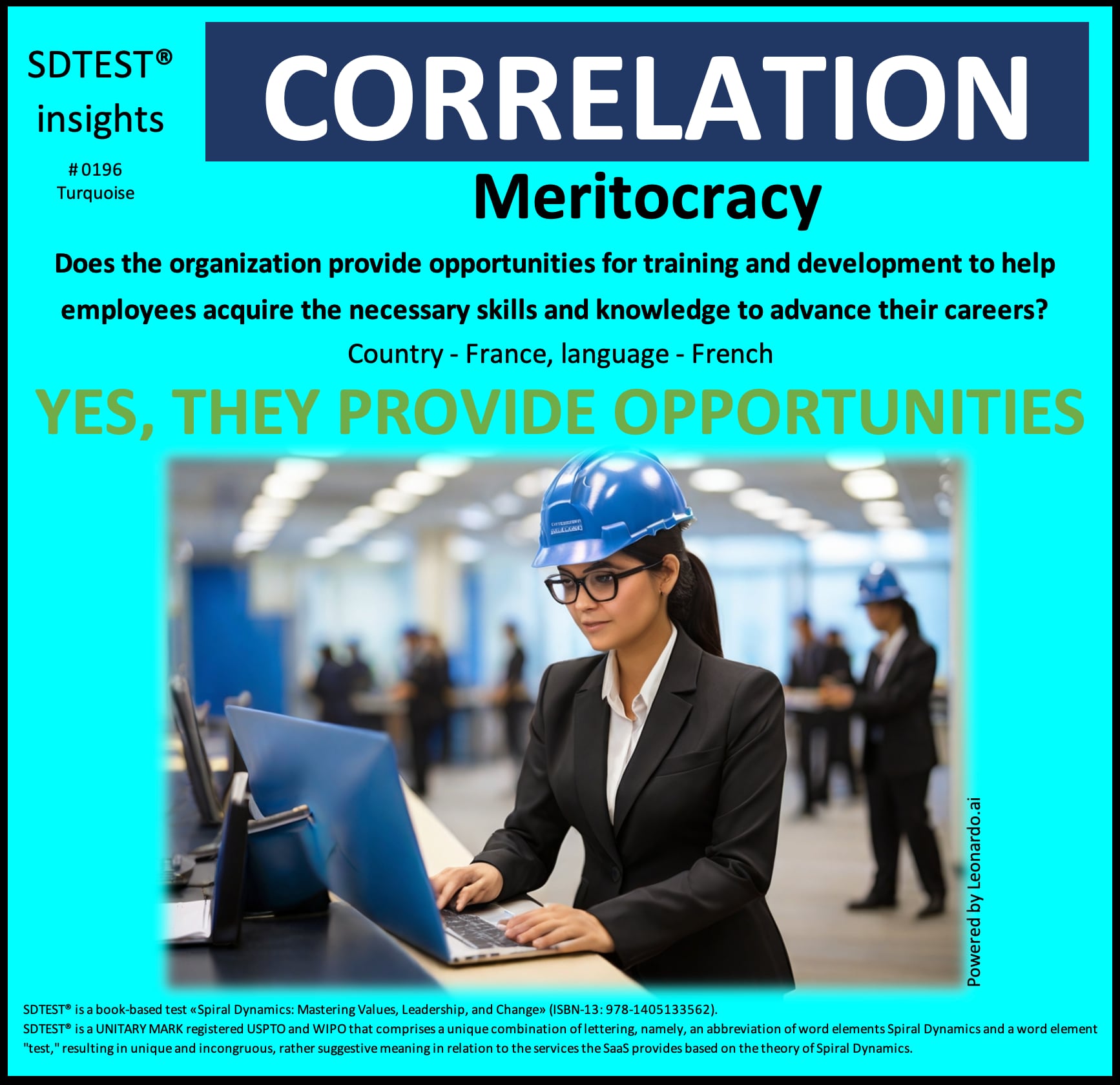
This positive correlation of 0.5672 between the organizational provision of development opportunities and the Turquoise stage offers profound insights into France's interconnected nature of personal growth, organizational evolution, and societal progress. Here's an analysis from three viewpoints:
Companies Perspective:
- Holistic Development: This correlation suggests that Turquoise-level companies in France recognize employee development as integral to addressing complex challenges such as climate change adaptation, social inequality, and the transition to a more sustainable economy.
- Interdependent Growth: These companies might view this correlation as an affirmation of their understanding that individual growth and organizational evolution are deeply interconnected with France's efforts to balance economic development with environmental protection and social cohesion.
- Sustainable Progress: The correlation is evidence that investing in human potential is key to creating resilient organizations that can navigate France's evolving socio-economic landscape, including challenges like an aging population and the need for energy transition.
Response:
- Implement comprehensive development programs that enhance professional skills and nurture ecological awareness and social responsibility, focusing on issues like renewable energy adoption, circular economy principles, and inclusive urban development in French cities.
Teams Perspective:
- Collective Consciousness: Teams might interpret this correlation as reflecting their collective growth towards a more integrated understanding of their role within France's diverse and evolving society.
- Symbiotic Learning: This insight could reinforce the idea that team learning and individual development are part of a larger process of societal evolution, addressing challenges like integration in multicultural communities and adapting to changing work patterns in France.
- Harmonious Collaboration: Teams may see this as validation of their efforts to create collaborative environments that reflect France's values of liberté, égalité, and fraternité in a globalized context.
Response:
- Foster team practices that blend professional development with activities enhancing cultural intelligence and social cohesion, such as collaborative projects addressing integration challenges in diverse French communities or promoting cross-cultural understanding.
Individuals Perspective:
- Holistic Self-Realization: Individuals might view this correlation as an affirmation of their journey towards self-realization within France's evolving national identity and its role in the European Union and global community.
- Aligned Purpose: This insight could reinforce their sense of alignment between personal growth aspirations and France's commitment to social and environmental progress, as reflected in policies like the French Climate and Resilience Law.
- Expansive Impact: Turquoise-level thinkers might see this as an encouragement to leverage their personal development to benefit their organization and France's broader societal and ecological systems.
Response:
- Engage in development opportunities that integrate professional skills with practices enhancing global awareness and ecological consciousness, such as participating in initiatives related to France's green transition or social innovation projects in urban and rural areas.
From a Turquoise perspective, this correlation invites us to explore the deep interconnections between individual development, organizational practices, and societal progress within the French context. As organizations evolve towards more holistic, integrated worldviews, they naturally create environments that support comprehensive human development, contributing to addressing France's complex social and environmental challenges.
In conclusion, this correlation offers a glimpse into the potential for organizations in France to serve as catalysts for holistic human development and societal evolution. It invites us to reimagine the purpose of business and career development in a way that honors the interconnectedness of all things and contributes to the health and harmony of both human and natural systems in France, Europe, and the global community.
What insights do you gain from today's correlation? How might we study this relationship more carefully before deducing causation?
We welcome respectful and wise perspectives! Stay tuned every week as we share more results and insights.
After login or registration, free access to the poll results in the FAQ section.
2024.07.14
FearpersonqualitiesprojectorganizationalstructureRACIresponsibilitymatrixCritical ChainProject Managementfocus factorJiraempathyleadersbossGermanyChinaPolicyUkraineRussiawarvolatilityuncertaintycomplexityambiguityVUCArelocatejobproblemcountryreasongive upobjectivekeyresultmathematicalpsychologyMBTIHR metricsstandardDEIcorrelationriskscoringmodelGame TheoryPrisoner's Dilemma
Valerii Kosenko
Mea nona ka huahana SaaS SDTEST®
Ua kūpono ʻo Valerii ma ke ʻano he kanaka aʻoaʻo-psychologist ma 1993 a ua hoʻohana ʻo ia i kona ʻike i ka hoʻokele papahana.
Ua loaʻa iā Valerii ke kēkelē laeoʻo a me ka hōʻailona papahana a me ka manakia papahana ma 2013. I ka wā o kāna papahana Master, ua kamaʻāina ʻo ia me Project Roadmap (GPM Deutsche Gesellschaft für Projektmanagement e. V.) a me Spiral Dynamics.
ʻO Valerii ka mea kākau o ka ʻimi ʻana i ka maopopo ʻole o ka V.U.C.A. manaʻo e hoʻohana ana i ka Spiral Dynamics a me ka helu makemakika i loko o ka psychology, a me 38 mau koho balota.

